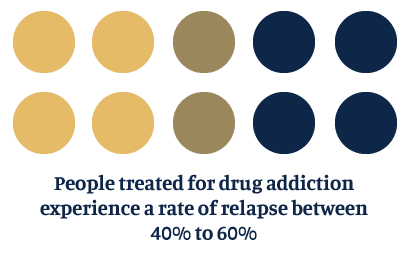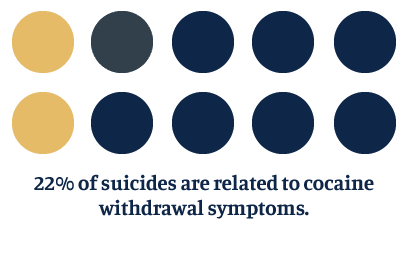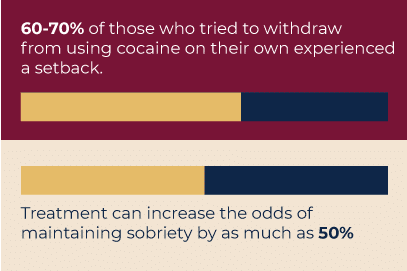Cocaine Addiction

Signs and Symptoms of Cocaine Addiction
Cocaine is a powerful psychoactive stimulant that alters how the brain functions. It is a white, powdery substance that reacts with the body’s central nervous system, producing energy and euphoria.
A large number of people experiment with the drug at some point in their lives. They may not know the many risks of cocaine use and its effects on a person’s mental and physical health. Research shows that nearly 25% of people who start using cocaine recreationally will develop an addiction.1
Find out what cocaine addiction truly is, learn its effects, and discover the best methods of treatment.
25% of people who start using cocaine recreationally will develop an addiction
History of Cocaine
Indigenous Use in South America
Cocaine is derived from the leaves of the coca plant which is native to South America. The people in the Amazon rainforest have chewed coca leaves to get a high for thousands of years. The coca leaf was also included in Inca cultural and religious ceremonies.
The first scientist to isolate cocaine from coca leaves was Albert Nieman . Around the same period, French chemist Angelo Mariani developed a tonic made from coca leaves and Bordeaux wine. He called it Vin Mariana and advertised as a drink that could “restore health and vitality.”
Scientific Use
An Austrian ophthalmologist named Carl Koller experimented with cocaine and used it as a surgical anesthetic during cataract surgery. Pharmaceutical companies began marketing cocaine and including it in various medicines. The enthusiasm about cocaine soon vanished as more patients started dying of accidental overdoses during surgery.
Freud’s Fascination
Even Sigmund Freud, the father of psychoanalysis, was fascinated with cocaine. He became addicted to the substance and struggled for 12 years to get sober.
Once a medical “wonder drug,” cocaine soon became the most addictive substance. Although the coca plant is harmless, the cocaine that is synthesized from the leaves is an addictive substance that has claimed many lives.
Early Laws to Fight Cocaine Abuse
One of the first laws about national drug legislation in the United States was the Harrison Narcotics Act of 1914. The Act effectively outlawed the sale and use of coca and opium products. The Narcotic Drugs Import and Export Act of 1922 prohibited the importation of cocaine and cocaine-containing products in the U.S.
More About Stimulants
Common Cocaine Street Names
The turbulent history of cocaine addiction has resulted in a long list of slang terms that people use. Each term is associated with the drug, its use, and the culture around it. As drug dealers try to stay ahead of the police and the DEA, new terms appear frequently.
Popular nicknames for cocaine that people have used over the years include:
Blow
Snow
Coke
Stash
Crack
Pearl
Rock
Bump
These different nicknames for cocaine are based on the appearance of the drug and how it is consumed. For example, regular cocaine comes in the form of white powder that people blow through the nose, thus the nickname “blow” or “snow.”
Crack is a crystallized form of the drug that became popular in the 1980s. The nickname “crack” is derived from the sound the crystallized rocks make when heated up.
Adding Other Drugs to Cocaine
Cocaine color and texture can be changed by adding certain additives. It is very common for cocaine and crack cocaine to be mixed with other substances such as marijuana, heroin, ecstasy, and LSD. These popular mixtures have their own nicknames, including:
Candy Flipping
Woolies
Speedball
Boy-Girl
Woo-Woo
Cocopuffs
Snow Seals
Flamethrowers
Learning the different nicknames can help people know if their loved ones are engaging in drug abuse. Users constantly change the terms in order to hide their habits from friends and family. Frequently updating one’s knowledge in terminology is crucial.
How is Cocaine Abused?
It has been found that 25 million Americans report having used cocaine at least once. The most common ways of using it are orally, intranasally, intravenously, and by inhalation.
Users may rub the drug onto their gums which is known as oral use. Some snort the powder through the nostrils, where it is absorbed into the bloodstream through the nasal tissues.
Moreover, other people dissolve cocaine in water and inject it through their veins. The drug enters the bloodstream and increases the intensity of the effects. Others inject a combination of coke and heroin, called a Speedball.
Another popular way of abusing cocaine is by smoking it. People heat up the cocaine crystal until it produces vapors that are inhaled into the lungs. The absorption into the bloodstream is as quick as by injection. Crack has also been seen sprinkled in marijuana or tobacco and smoked like a cigarette.
How Much is Cocaine Used?
Cocaine addiction is expensive. It contributes to the $11 billion in healthcare costs and $193 billion in costs created by illegal drug use in the US.3 The psychological and physical effects are much more costly.
According to the National Institute of Health (NIH), adults aged 18 to 25 years are more prone to developing a cocaine addiction than any other age group. The National Institute on Drug Abuse (NIDA) found that in 2018, 1.4% of 8th graders, 2.6% of 10th graders, and 3.9% of 12th graders used the drug at some point in their life.4
In 2014, a study found that within the previous 12 months, more than 900,000 were addicted to cocaine. This means that 0.4% of the U.S. population suffers from cocaine addiction.5
How Does Cocaine Affect the Body?
What the substance does is release a large dose of neurotransmitters into the brain’s reward system. Three types of neurotransmitters are present, including dopamine, norepinephrine and serotonin.
Internal Effects of Cocaine
The high levels of dopamine in the brain can lead to:
Feelings of Euphoria
Pleasure
Emotional High
Increased concentrations of norepinephrine can produce a variety of effects throughout the body, including:
Increased Energy
Increased Body Temperature
Constricted Blood Vessels
Increased Heart Rate
Dilated Pupils
Increased Blood Pressure
Observable Effects of Cocaine
Higher levels of serotonin are associated with greater confidence. Some other acute effects of cocaine might include:
Talkativeness
Overconfidence
Decreased appetite
Alterness
Extreme sesitivity to touch, sound, and sight
Anxiety
Paranoid feeling
The effects of cocaine abuse depend on how people use the drug. For example, the effects of snorting the drug are more short-lived and last for about 15-30 minutes. Smoking or injecting the substance can have more intense effects on the human body, although they last for about 5-10 minutes. Injecting the drug also poses a higher risk of overdose than snorting.
Major Health Risks of Cocaine
Over time, the abuse of cocaine can have many negative health effects on every part of the human body. It can cause severe long-term effects such as changes to:
Genetics in brain cells
Nerve cells and proteins
Heart conditions
Stomach issues
Lung problems
The human brain is constantly striving for balance. If a person uses the drug regularly, the brain will begin to notice that is constantly bombarded with dopamine. As a result, the brain’s dopamine receptors will re-adjust and become lower.
So, if people take cocaine often, they will notice that the strength of the effect will lessen. At this time, the person will have developed a physiological tolerance to coke’s effects. That person will have to take more to get the same euphoria. The end result might be a dangerous addiction or overdose.
Life Threatening Risks
The most life-threatening health risks of cocaine overdose are
Heart Attacks
Strokes
Seizures
Irregular Heart Rhythm
Other side effects include
High Blood Pressure
Extreme Anxiety
Hallucinations
Difficulty Breathing
Lifestyle and Medical Risks
More frequent coke abuse with stronger doses can also alter a person’s brain chemistry. The body and mind will start to rely on the drug, making it more difficult to think, sleep, and remember things. A person’s reaction time might slow down. There is also a higher risk for heart, stomach, and lung problems.
The list of serious side effects and health problems of cocaine addiction includes:
Headaches
Mood problems
Sexual problems
HIV or hepatitis if injected
Bowel decay if swallowed
Loss of smell, nosebleeds, runny nose, if snorted
Misconceptions About Cocaine Addiction
On TV, cocaine use is often portrayed as a glamorous drug that displays a person’s status. However, in reality, addiction often causes people to lose their jobs, their families, their homes, and their reputation.
Here are four of the most common myths surrounding the addiction:
Misconception #1: It Takes A Long Time To Get Addicted To Cocaine
Contrary to popular belief, cocaine is a highly addictive substance. People can get addicted to the drug, both physically and psychologically, after only a few uses.
Misconception #2: Cocaine Makes You A Better Athlete Or Worker
This belief has been proven to be false when a study by the International Journal of Cardiology found that exercising after taking cocaine increases the risk of irregular heartbeat and potentially death.
Misconception #3: Cocaine Does Not Pose Any Health Risks
Coke abuse can have many negative health effects on the human body. It can cause severe long-term effects such as changes to genetics in brain cells, heart, stomach, and lung problems, as well as seizures, strokes, and ultimately death from an overdose.
Misconception #4: Cocaine Improves Sex Experience
In spite of its reputation as an aphrodisiac, the substance can negatively influence sex drive. There is a link between cocaine, erectile dysfunction and a lower sperm count.
Cocaine Withdrawal
Cocaine withdrawal happens when a person who has abused the drug cuts down or quits taking the drug. Withdrawal is also the most important part of any treatment program. People who are addicted to the drug and sign up for a treatment plan must go through a phase called withdrawal when the body is cleared of the toxin.
Crash Phase
When a person stops using cocaine, the first phase is called the crash phase. The duration and intensity of the crash depend on the quantity and quality of the drug and other substances that were taken concurrently. A coke crash period can last from one to 40 hours following the final dose.
Withdrawal Phase
The second phase is the withdrawal phase. During this phase, people might experience symptoms such as lethargy, anxiety, and cravings, paired with fond memories of their drug experience. For some, the withdrawal symptoms can become so great that they often relapse. Although it is difficult to pin down exact relapse statistics, NIDA suggests that people treated for drug addiction experience a rate of relapse between 40% to 60%.6


Moreover, one study found that people with a history of depression who use cocaine are up to five times more prone to experiencing withdrawal symptoms and have more severe cravings. Another study discovered that up to 22% of suicides might be related to cocaine withdrawal symptoms.
The cocaine withdrawal period can continue for up to ten weeks. The most common symptoms include:
- Depression
- Anxiety
- Fatigue
- Hyperactivity
- Trouble Concentrating
- Increased Hunger
- Cravings for the Drug
- Vivid Dreams
- Tremors
Extinction Phase
The third phase of the withdrawal period is called the extinction phase. During this phase, the person experiences less severe cravings and learns how to master their resistance to the cravings.
Many treatment centers offer detoxification services to patients who need help. With the assistance of a healthcare expert and close supervision by a medical team, patients can safely flush the toxins from their system and get ready for the recovery process.
Different Therapies and Approaches to Cocaine Abuse Treatment

Once the person flushes the drug out of the system, the next step in treatment is developing coping mechanisms that will help maintain ongoing sobriety.
According to one study, roughly 60% to 78% of those who tried to withdraw from using cocaine on their own experienced a setback. Moreover, NIDA found that treatment can increase the odds of maintaining sobriety by as much as 50%.
There are several treatment options for treating cocaine addiction, and the most common include:
Contingency Management (CM) Therapy
This type of treatment is a prize-based system in which patients earn points or chips that can be exchanged for movie tickets, dinner at a restaurant, or gym membership. It motivates patients to fight their addiction and encourage healthier living.
The core idea of the treatment is that behaviors that are rewarded are more likely to continue with increased intensity, duration, and frequency. The therapy can be used as a stand-alone treatment or in combination with other types of treatment, including:
Cognitive-Behavioral Therapy
Medication Management
Motivational Interviewing
Cognitive Behavioral Therapy (CBT)
CBT is a behavioral therapy that has proven to be effective in preventing cocaine addiction.
Patients learn how to develop skills that are crucial for supporting long-term abstinence. These skills include the ability to recognize tempting situations that can trigger a relapse, avoid those situations, and cope more effectively with the problems associated with coke abuse.
This therapy can be used in combination with other treatments for maximized effects, including Contingency Management and group meetings.
CBT is a short-term therapy that can last anywhere from five to 20 sessions. The duration of the treatment depends on the severity of the addiction.
Rehab Centers
Drug-free residences that offer ongoing treatment can be an effective method for battling with cocaine addiction. These rehab centers require a 6- to 12-month stay and can include services such as:
- 24/7 nursing supervision
- Medication management
- Individual and group therapy
- Cognitive-behavioral therapy (CBT)
- Dialectical behavioral therapy (DBT)
- Nutritious, nourishing meals
- Reflective activities like yoga and meditation
- Aftercare
Patients can choose between inpatient and outpatient type of rehab. During inpatient rehab, the patient lives at the rehab center under the supervision of doctors, nurses, and clinicians. They participate in a number of therapies and activities on-site, including CBT, medication management, and meditation.
During outpatient rehab, the patient lives off-site in a sober living house or their own home. This type of rehab is recommended for patients with less severe addictions or those who cannot leave their jobs or families.
Community-Based Recovery Groups
Community recovery groups such as Cocaine Anonymous that follow the 12-step program can also be effective. Participants can greatly benefit from the supportive environment and close contact with other people who are battling with the same problems.
Dual Diagnosis Treatment
In many cases, addiction and a mental health condition go hand in hand. When they happen at the same time, they are referred to as a dual diagnosis or a co-occurring disorder. A person might suffer from a mental health condition prior to developing an addiction, or the mental health condition might appear after the patient starts experimenting with the substance. Addressing both the mental health issue and addiction is crucial for long-term sobriety.
Key Takeaways
There are several key takeaways to keep in mind when it comes to cocaine addiction:
Cocaine is a powerful psychoactive stimulant that alters how the brain functions. It is a white, powdery substance that reacts with the body’s central nervous system, producing energy and euphoria.
Learning the different nicknames for cocaine can help people know if their loved ones are engaging in drug abuse.
The most life-threatening health risks of cocaine overdose are heart attacks, irregular heart rhythm, seizures, and strokes. Other side effects include high blood pressure, difficulty breathing, hallucinations, and extreme anxiety.
Contrary to popular belief, the drug is a highly addictive substance that will not make a person a better athlete or worker. Also, it can negatively influence a person’s sex drive.
The most common types of treatment for cocaine addiction include detoxification, behavioral therapies, treatment at rehab centers, 12-step recovery meetings, and dual diagnosis treatment.
Begin Your Path to Recovery
If you or a loved one are struggling with addiction, it’s time to ask for professional help. Reach out for help today and learn how you can begin your path to recovery.
Resources
- https://www.merckmanuals.com/professional/special-subjects/recreational-drugs-and-intoxicants/cocaine
- https://www.pbs.org/wgbh/pages/frontline/shows/drugs/buyers/socialhistory.html?_ga=2.248513797.320679522.1564994792-1360696801.1564994792
- https://www.drugabuse.gov/related-topics/trends-statistics
- https://www.drugabuse.gov/trends-statistics/monitoring-future/monitoring-future-study-trends-in-prevalence-various-drugs
- https://www.drugabuse.gov/publications/research-reports/cocaine/what-scope-cocaine-use-in-united-states
- https://www.drugabuse.gov/publications/drugs-brains-behavior-science-addiction/treatment-recovery














